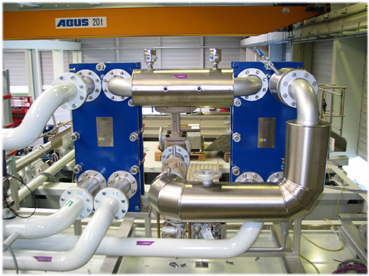The Krones Variotherm cuts bottle washer heating costs
Availability, resistance to malfunctions and high efficiency are vital considerations for bottle washers. Since bottle washers rank among the most cost-intensive pieces of equipment in a line, Krones AG, Neutraubling, Germany, has developed a new plate heat exchanger system called Variotherm, designed to reduce the heating costs involved.
Significantly improved heat transfer
The innovation of a plate heat exchanger relates to bottle washers featuring more than one caustic bath. The new system comprises a primary and a secondary plate heat exchanger. In the primary heat exchanger, a caustic bath is heated up using the steam available or another suitable medium. This caustic bath, heated by the primary circuit, usually has the highest temperature level in the system. This hot liquid is used in another plate heat exchanger to heat up the second treatment zone, plus a third if necessary. The bath heated by the primary circuit need not necessarily be the first caustic bath: it is quite conceivable that the first caustic treatment zone is run at 65°C and the second caustic bath exhibits an operating temperature of 80°C. With this constellation, the primary and secondary circuits are simply exchanged.
The plate heat exchangers used excel in terms of a heat transfer value up to five times better than the countercurrent heat exchangers customarily employed.
Fuel costs cut by 5 – 30 per cent
Besides its superlative heating performance, this system possesses another thermodynamic advantage: the design concept precludes any re-evaporation. This means that the entire evaporation enthalpy present is available to the system. But the water heat contained in the condensate is utilised almost 100 per cent. This state is referred to as “supercooled” condensate. This highly efficient use of the thermal energy fed in will save the client concerned about 5 – 30 per cent a year in fuel costs.
But the heating system also has plenty to offer in terms of operational dependability. In conventionally operated systems, the primary-side temperature control has the serious disadvantage of steam shocks on the condensate side or an enormous proportion of re-evaporation. Energy requirement is now controlled on the “condensate side” of the system. The key phrase here is “condensate back-up supercooling”. This enables the downstream pipes and fittings to be designed and constructed as a “water piping system”, which cuts the capital investment costs significantly.


